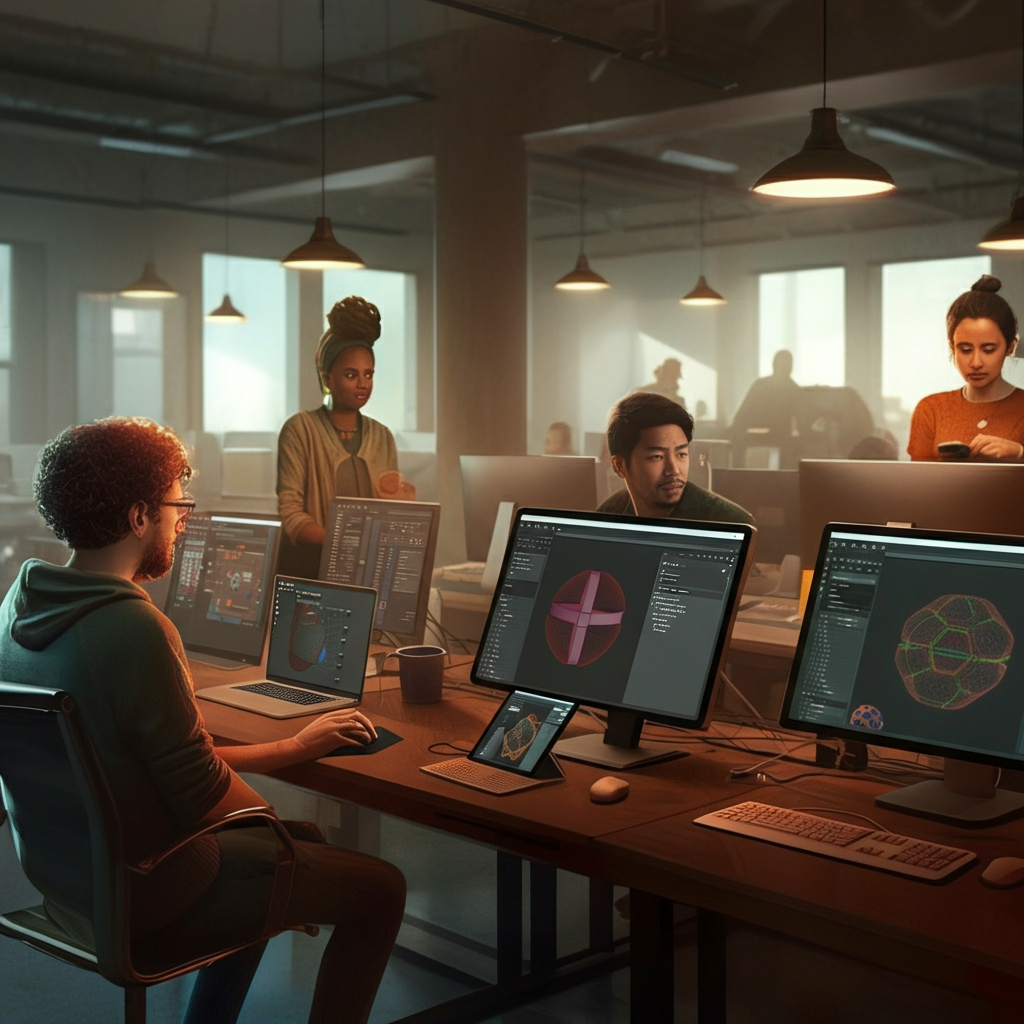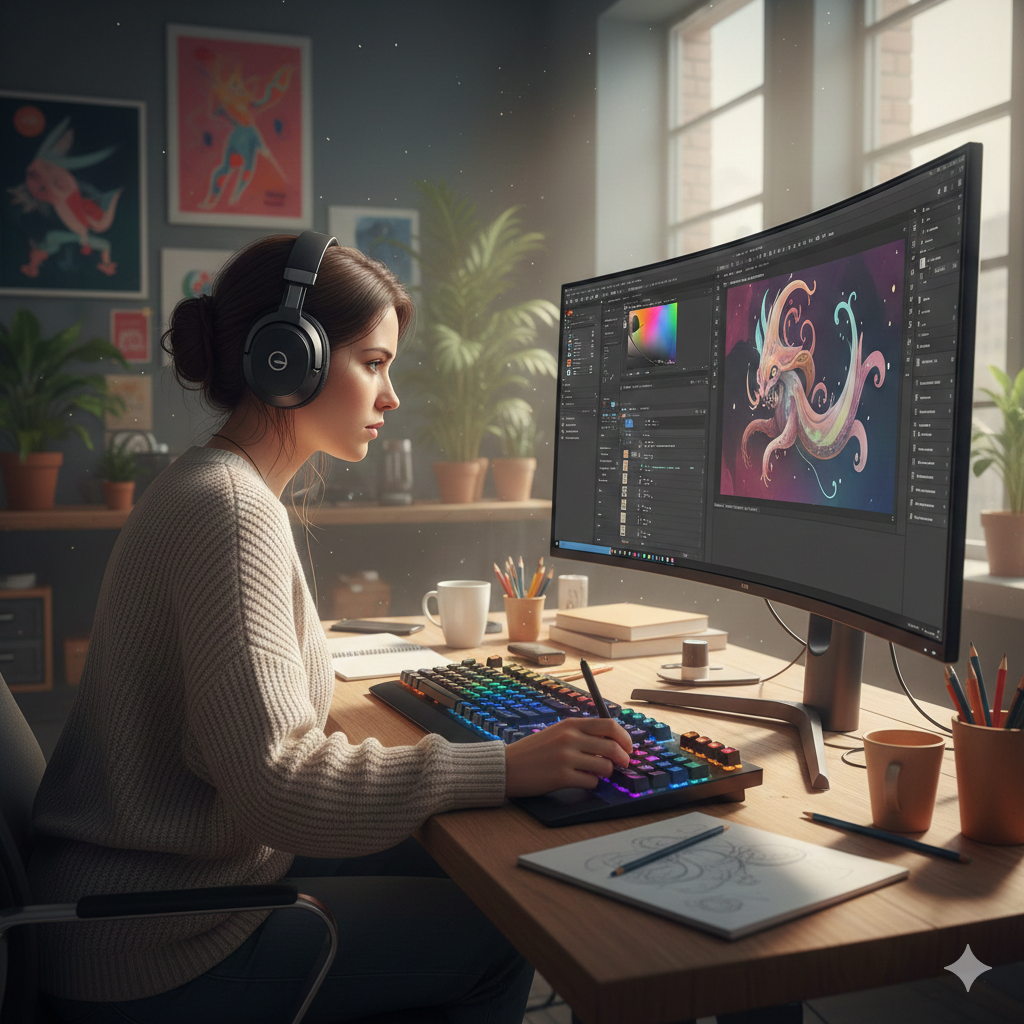3D software : what are the uses in creating product catalogs?
La 3D modeling has revolutionized product development in numerous sectors. But its potential does not stop at design offices. Businesses are now discovering how to exploit their existing 3D resources to radically transform their commercial communication.
One 3D software allows you to create, modify and visualize three-dimensional objects using tools from modelling, of surrendered And ofanimation. These technologies, formerly reserved for designers, are becoming valuable allies for teams. marketing and communication.
The real opportunity lies in the ability to automatically transform these 3D models in professional commercial supports. Gone are the days when teams had to redo all the visual work: the chain can now be fluid, from technical design until the publication of catalogues.
This evolution is based on the interconnection between modeling tools, the product data management systems (PIM) And the layout software. The result? Of automatically generated product catalogs, updated in real time and fully consistent with technical specifications..
🎯 Save time by integrating your 3D visuals directly into SolidDesigner.
What is 3D software?
A 3D software is a computer program that makes it possible to model, texturing, liven or visualize objects in a three-dimensional space. These tools offer a complete virtual representation of products, with their dimensions, shapes, materials and visual properties.
Software solutions on the market
The market offers a wide range of solutions adapted to different needs. SolidWorks dominates the industrial sector with its capabilities of advanced mechanical design, allowing engineers to create accurate models with technical constraints. Blender Seduced by her versatility And her Gratuity, offering professional functionalities accessible to small structures.
3ds Max remains the reference forarchitecture And theanimation, particularly appreciated for its ability to photorealistic rendering. SketchUp is distinguished by its ease of use, ideal for rapid prototyping And the customer presentations. Rhino excels in complex organic modeling, favoured by industrial designers And the jewelry designers.
File formats and compatibility
These programs generate various extensions according to their specific use. The formats OBJ and STL are perfect for3D printing thanks to their simple geometric structure. FBX facilitates exchanges between different platforms, maintaining the textures and animations. GLTF optimizes theweb display And the mobile applications with effective compression.
This diversity of formats allows flexible integration in various communication workflows. The challenge is to choose the right format for the end use: high quality printing, webcast, interactive animation or technical archiving.
What is the purpose of 3D software in a marketing context?
Creation of visuals without physical constraints
Marketing teams can take advantage of the 3D to create product visuals without organizing expensive photo shoots. This approach offers a total creative freedom : changing colors, changing viewing angles, addingsophisticated lighting effects. Logistical constraints disappear since products do not need to be physically available.
La quality of 3D renderings Now reaches levels impressive photorealists. The technologies of Ray Tracing and the libraries of advanced materials allow you to faithfully reproduce the visual properties of materials : metallic brilliance, glass transparency, leather texture.
Versatility of visual representations
3D renderings make it possible to produce realistic images, of technical exploded views Or stylized representations according to communication needs. The same model can generate dozens of different visuals, adapted to each medium and each commercial message.
Les exploded views Reveal the internal complexity of products, valuing thetechnical expertise for professional customers. Les stylized renderings create a distinctive visual identity, particularly effective for general public communication campaigns.
Flexibility and product adaptation
La flexibility is the major advantage of this approach. Businesses can easily adapt their visuals according to product lines, the available dimensions Or the specific configurations. A modification on the 3D model has repercussions instantly on all the media concerned, guaranteeing a perfect consistency.
This adaptability is crucial for businesses offering numerous Product variants. THEautomotive industry, for example, can present each model in all its variations of colours And ofequipments without multiplying photo shoots..
💡 With SolidDesigner, your 3D renderings can be automatically linked to your product sheets or catalog pages.
3D + PIM + InDesign: the new value chain
Integration of product data and 3D visuals
The integration between 3D modeling, product data management (PIM) and automated layout is revolutionizing the creation of commercial materials. This technological convergence allows manufacturers and brands to drastically optimize their editorial processes.
Les centralized product data in a PIM system can now automatically control the generation of 3D visuals. Dimensions, materials, colors available : each product attribute directly influences the final visual result. This dynamic link guarantees a perfect consistency between technical specifications and their commercial representation.
Layout automation
THElayout automation Through connected InDesign templates is transforming the production of catalogs. A multilingual technical catalog, including hundreds of references with their specific 3D visuals, can be generated in a few hours instead of several weeks.
Les smart templates automatically adapt the layout according to the type of product, the number of images available and the format constraints. This flexibility makes it possible to maintain a graphic coherence while optimizing thespace available for each reference.
Concrete use cases
This approach is particularly effective for companies managing wide product ranges. The addition of a new reference automatically triggers the creation of its 3D visuals and their integration into existing supports, according to predefined layout rules.
The sectors ofindustrial equipment, of theHousehold appliances And of theautomotive take full advantage of this automation. La complexity of ranges And the frequency of product launches make this systematized approach indispensable..
📘 Discover how SolidDesigner connects your 3D files to your product sheets in a few clicks.
How to integrate 3D visuals into your communication media?
Choosing the optimal export formats
The successful integration of 3D visuals requires mastering export formats adapted to each use. For thehigh quality printing, give priority to vector formats suchlike PDF or PES, which maintain sharpness at all resolutions. These formats guarantee a optimal quality even for large print formats.
Les high definition raster images (PNG, TIFF) are suitable for web applications and screen visualizations. The PNG format maintains transparency, ideal for montages and overlays. The TIFF Offer a lossless compression, perfect for archiving and subsequent retouching.
Rendering settings and optimization
The conversion from 3D software to these formats requires particular attention to render settings. Resolution, colorimetric profiles, transparency management : each element influences the final quality And the compatibility with layout tools.
Les CMYK color profiles are required foroffset printing, while the RGB profiles optimize thedigital signage. The management of extended color spaces (Adobe RGB, ProPhoto RGB) preserve the chromatic richness the most sophisticated 3D renderings.
Automation solutions
SolidDesigner Simplify this step by automating the export and the conversion of 3D visuals to optimal formats. The solution intelligently manages technical parameters and ensures a smooth integration in InDesign templates. Teams can focus on contents And the creativity rather than on the technical aspects.
The tool also offers advanced features Like the automatic generation of visual variants, theadaptation to different page formats, or the Real-time synchronization between 3D modifications and media updates. This automation Eliminate risk of error and accelerates considerably the production deadlines.
Why is 3D becoming essential for produced documents?
Savings and productivity gains
Les savings generated by the abandonment of traditional photo shootings represent a weighty argument. One professional photo shoot costs several thousand euros and requires the physical availability of the products. La complex logistics, the studio rentals, the mobilization of technical teams : all these costs disappear with the3D approach.
3D makes it possible to create visuals even before the prototypes were manufactured, considerably speeding up the development cycles. This anticipation Offer a major competitive advantage, especially in sectors where speed of placing on the market Constitutes a key success factor.
Limitless creative flexibility
La flexibility of declination offered by 3D greatly surpasses conventional photographic approaches. Modifying a color, changing an angle of view, adding a specific environment: all these operations are done in a few clicks without mobilizing new resources.
This suppleness allows visuals to be quickly adapted to specificities of each market or distribution channel. The same product can be presented in a industrial environment for professionals and in a domestic frame for individuals, optimizing the commercial impact of each medium.
Coherence and commercial reactivity
This approach guarantees a perfect visual coherence on all communication media. Paper catalog, e-commerce site, POS, commercial presentations: all use same reference visuals, generated according to a unified graphic charter.
THEspeeding up product updates constitutes a decisive competitive advantage. Businesses can launch their new references on the market with comprehensive sales supports, without waiting for the photo campaigns to be finalized. This responsiveness significantly reduces the Time-to-Market and improves the response to business opportunities..
🚀 Do you use 3D in your product process? Take it to the next level with SolidDesigner to generate all your supports automatically.
Frequently asked questions about using 3D for catalogs
What 3D software is the most suitable for creating catalogs?
The choice depends on your sector of activity and your technical constraints. SolidWorks is perfect for industrial products thanks to its dimensional accuracy. Blender offers a versatile free alternative for most needs. KeyShot excels at photorealistic rendering for marketing presentations.
How to ensure the quality of 3D renderings for printing?
Print quality requires high resolutions (300 DPI minimum) and rigorous management of colorimetric profiles. Use coherent lights And calibrated materials. Les print tests on various media allow you to adjust the rendering parameters to obtain the optimal result.
How long does it take to automate catalog creation with 3D?
The initial set-up generally requires 2 to 4 weeks according to the complexity of your product range. This phase includes the creation of templates, the configuration of automatic links And the team training. Les productivity gains appear as soon as the first catalogs generated automatically are created.
Can 3D animations be integrated into digital catalogs?
Digital catalogs allow the integration oflightweight 3D animations, particularly effective for presenting product features. The formats GIF or Optimized MP4s maintain a reasonable file size while enriching theuser experience. THE360° animation is an excellent compromise between visual impact and technical constraints.
Transform your 3D assets into business assets
The integration of 3D software in the creation of product catalogs represents much more than a simple technological evolution. This approach is fundamentally changing the way businesses design, produce and distribute their commercial communication.
La fluidity of the chain between 3D design, product data management and automated publishing is now a major differentiating factor. Organizations that master this integration benefit from a sustainable competitive advantage : increased reactivity, optimized costs, reinforced quality.
The future belongs to businesses that are able to transform their technical resources into commercial assets. 3D offers this unique opportunity to immediately value design investments in all communication media. This synergy between technical innovation and marketing effectiveness, redefines performance standards in the creation of product content..
📥 Try SolidDesigner for free and turn your 3D visuals into print-ready pages effortlessly.












.webp)






